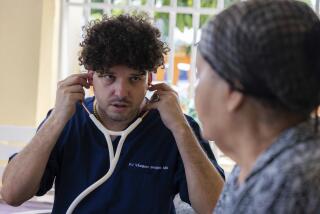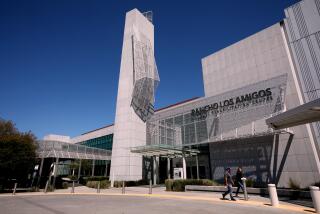W. Texas Communities Hope Hospitality Will Draw Doctors to Hospitals
- Share via
AMHERST, Tex. — The 900 residents of this Texas farming community vow that the next time a prospective doctor comes to town, it will be one heck of a house call.
The chili will be extra spicy, the chicken mesquite-grilled to perfection and the steaks lavished in hickory barbecue sauce.
Bands will twang at a town square hoedown. The schools and churches lining Amherst’s brick streets will be shown off.
It may be a little extreme, even for West Texas hospitality, but people say such a reception would show only a fragment of their desire to find a doctor to reopen the town’s hospital.
“If we could get someone to come out and visit, there is unbelievable support here,” said Carol Hill, interim administrator of Amherst’s closed South Plains Hospital. “You give us a couple days notice and you wouldn’t believe the response.”
Amherst is not alone. Several rural Texas towns are in search of a doctor. But odds are against them, officials say.
Texas has led the nation in hospital closings for five years. And the Texas Hospital Assn. estimates that the 193 rural hospitals in the state will lose nearly $20 million in Medicare services in 1991.
“Because so many of the patients in rural areas are on Medicare, there isn’t a whole lot of incentive to practice in small towns,” said Marvin Cole, director of the rural hospital branch of the THA.
In Amherst, the hospital was for 50 years the second-largest employer, behind the school, and the only haven for medical care in miles of treeless farmland.
But in July, 1989, the fifth of five doctors resigned from the hospital, forcing it to close.
Seven years earlier, the old hospital had been replaced with a 35-bed medical center containing the amenities of many urban hospitals. It stands out among the area’s barns and grain silos.
But today, delivery, emergency, X-ray and recovery rooms filled with shiny, new equipment are going unused. An electrocardiograph sits unplugged in an operating room. Eight bassinets lie empty in a darkened nursery.
And hundreds of medical records for patients who used to drive more than 50 miles to see doctors in Amherst now collect dust.
“I never dreamed it would close,” said city secretary Gayla Cowan, who was born in 1940, the year the old hospital opened. “I guess we just all thought it would be there forever because it had always been here.”
South Plains, which has continued to operate a pharmacy to pay outstanding overhead, is searching for a doctor, physician’s assistant or nurse practitioner to reopen the hospital’s X-ray lab and clinic. Two or three doctors are needed to reopen the hospital.
But shortcomings in Medicare payments, rising insurance costs and sometimes days in a row on call have made family practitioners reluctant to practice in rural areas.
Residents know what they are up against and have raised nearly $40,000 to reopen South Plains.
“Unless federal programs change, it’s going to be hard for someone to justify the move out here,” said Clyde Brownlow, the pharmacist at South Plains for 22 years. “But not a day goes by when someone in town doesn’t ask me if we have found a doctor.”
The Prospective Payment System, implemented by the federal government in 1983, pays rural hospitals up to 40% less than urban hospitals for Medicare patients. The system was created with the belief that it cost less to run a rural hospital.
Gordon Russell, administrator of Hi-Plains Hospital in Hale Center and a crusader for rural health in Texas, says the system caused 12 rural Texas hospitals to close last year.
“It gives me great pain to think about how little money it would have taken to keep them open if we had an equal urban-rural ratio,” Russell said. “But, once the hospitals close, it’s almost insurmountable to get them back open again.”
University programs designed to increase the number of rural doctors and some federal financial aid are steps in the right direction, officials say.
The Texas Tech Medical School provides several incentives to lure young physicians to West Texas, including tuition breaks, said Jim Chappell, associate dean of admissions and student affairs at the university’s School of Medicine.
“All other things being equal, we will give preference to a West Texan to medical school,” Chappell said. “If we get somebody who was raised in Pampa, they are more likely to go back there” after graduation.
Cole said a government program called Rural Health Clinic, which helps pick up the tab for emergency services, is catching on. To qualify for aid, a hospital has to be in an area that suffers a “health manpower shortage,” a ratio of one doctor to 3,500 residents, he said.
Areas with high poverty rates, a large population older than 65, and those with a shortage of doctors also qualify, Cole said.
Aside from federal help, a small community must continue to try to attract a doctor with an extra special Texas welcome, officials say.
“One of the most critical aspects of bringing a doctor in is the support of the hospital. But as important is the support of the community,” said David Johnston, senior search consultant for Merritt Hawkins, a physician placement firm based in Dallas.
“Lack of support by the community, and I mean visual support, can hurt the chances of landing the doctor every time,” said Johnston, whose firm recently placed a physician in Crosbyton, outside Lubbock, with a massive outpouring of support by residents.
In Amherst, Hill says visual and even tasty support for a prospective doctor will be no problem.
“There are a lot of good cooks around here and they would love to show that off,” she said. “I hope the doctor comes out with a big appetite. He would need it.”
More to Read
Sign up for Essential California
The most important California stories and recommendations in your inbox every morning.
You may occasionally receive promotional content from the Los Angeles Times.










